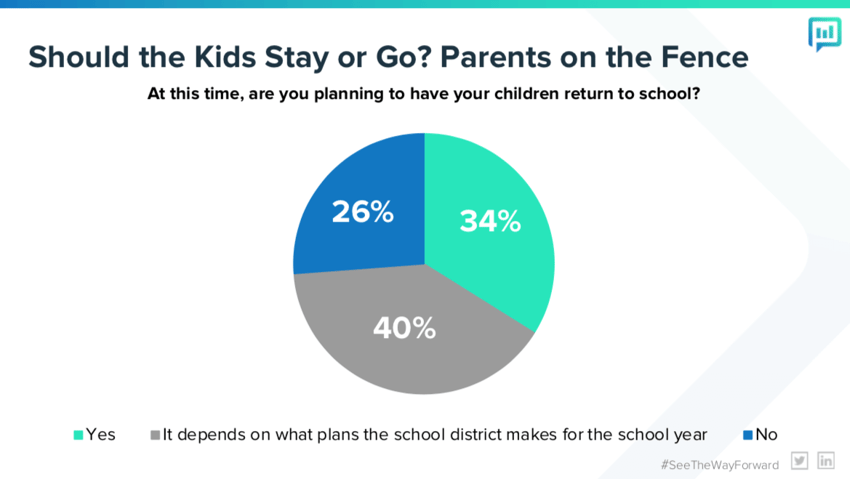![Insights Discussion: Back to School Blues: How Will Changes in Employee Productivity Affect Your Organization's Fall Outlook [RECAP]](https://blog.perceptyx.com/hs-fs/hubfs/working-from-home-arrowed-1.jpg?width=480&height=210&name=working-from-home-arrowed-1.jpg)
Insights Discussion: Back to School Blues: How Will Changes in Employee Productivity Affect Your Organization's Fall Outlook [RECAP]
For many companies, self-reported productivity and engagement improved during the last few months as remote work continued and the school year ended. As time passes and a new school year quickly approaches, questions emerge as to whether these patterns will remain. Brett Wells, Perceptyx’s Director of People Analytics, and Al Adamsen, People Analytics and Future of Work’s Founder and CEO, explored these questions, sharing research from a recent panel study (1) and providing tips for organizations navigating the back to school blues.
Managers Influence Safety Practices
When it comes to returning to the physical work environment, employees rated required face masks as the most important factor to feel safe. Face mask requirements were viewed as even more important in riskier environments where COVID-19 cases are highest.
Even though personal face mask wearing differs, manager support continues to play a critical role in acceptance of new policies. For employees who never wear face masks personally, less than 1 out of 10 were in favor of wearing masks at work when they also had a manager who did not support their overall well-being. When managers showed high support for employee well-being, over half of employees who never wear face masks personally were in favor of organizations requiring them at work. Once again, employee perceptions “hinge on the relationship with managers,” Brett noted, highlighting the importance of developing supportive managers.
.png?width=850&height=477&name=Screen%20Shot%202020-07-30%20at%201.50.51%20PM%20(1).png)
Although face mask requirements were rated as the most important factor for feeling safe, Al cautioned about the nuances of mask wearing, noting that cultural norms around mask wearing are still being developed. Organizations must be careful to instill confidence when presenting new procedures, making it clear the organization is looking out for employees’ well-being and providing an environment for them to be successful. Al encouraged organizations to “find what is reasonable” based on your type of work, geography, and culture. We have to identify “what habits we are going to promote” and “find what is appropriate” for each organization and job, Al explained.
Back to School Uncertainty
Even though school is quickly approaching, many parents are still uncertain as to whether their kids will return to a traditional classroom. According to the panel study, 40% of parents have not made a decision about whether their kids will return to a traditional classroom, Brett explained, with many still waiting for school districts to provide clearer guidance. For employees already working in a physical workplace or with children needing individualized education plans, a return to a traditional classroom was 2 times more likely, but the majority were still considering hybrid or remote options.

Organizations need to enter an “acceptance phase,” Al Adamsen urged, explaining organizations must provide a level of clarity for their employees now. “From an organizational perspective, we need to be really frank so [employees] can deal with the reality” and organizations can “resource & support them appropriately.” To ensure employees are not only productive but also healthy and safe as children go back to school, organizations must understand the individual challenges each employee faces and identify what specific support is needed. A “level of innovation” is needed, Al explained, calling for greater agility and creativity.
Listen to Individual’s Back to School Blues
For many employees, there is no choice between traditional, remote or hybrid learning, with many schools already announcing mandatory remote learning policies. Research presented by Brett revealed both parents and non-parents are expressing concerns about the upcoming remote school year. For parents, 60% believe distance learning will place an extremely difficult burden on their families. Burdens associated with remote learning were especially concerning for mothers who are Executives. For non-parents, 1 in 4 believe their workload has increased because of parents.
Organizational support is critical to retaining employees during this challenging time, Brett explained. Parents were 25% more likely to say they intend to stay with their organization when the organization provides the flexibility to work from home when children are also home.
To support working parents, organizations “have to be willing to go down to the individual level,” Al explained. We must have the very human discussions of how we can support people individually. Employees must feel safe to be vulnerable so organizations can do their best to promote well-being and productivity. “Authentic conversations are paramount,” Al stated. We must create the space for employees to acknowledge what support they need and be creative to get them where they want to go. We must have that discussion to create new ways forward.
(1) Recent Panel Study: Perceptyx conducted a paid panel research study, from July 17 through July 20, in which over 1,500 U.S. employees, 18 years and older, responded to questions about organizational health and safety practices. Employees who are parents answered additional questions about the return to school, whereas non-parents answered additional questions about their coworkers who are parents.